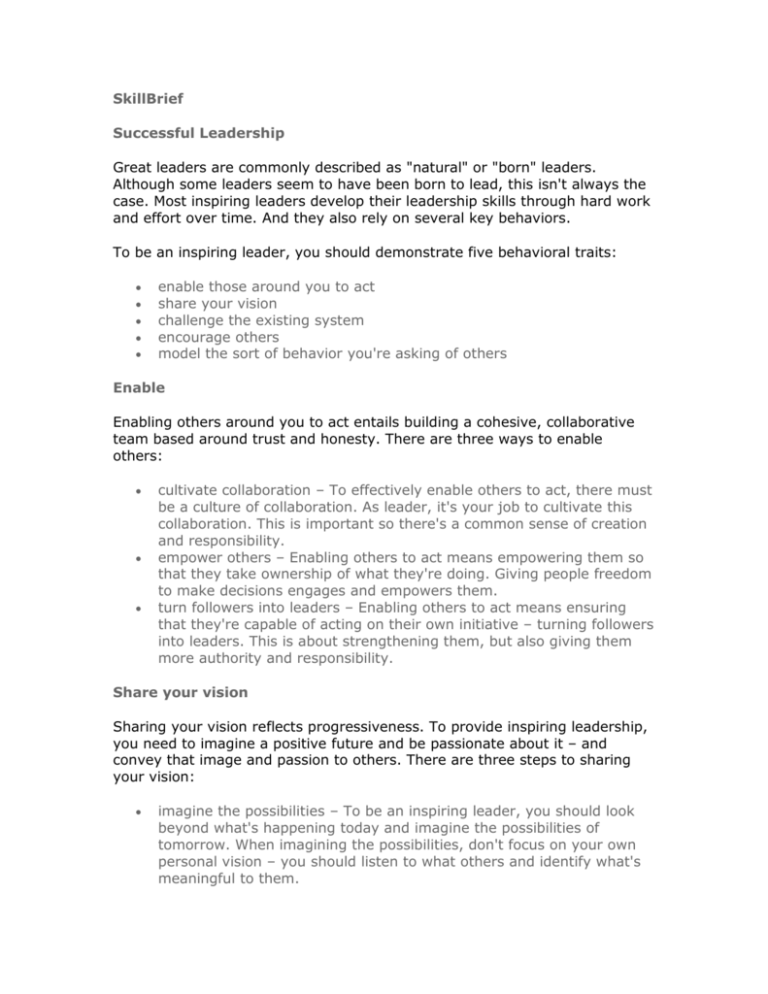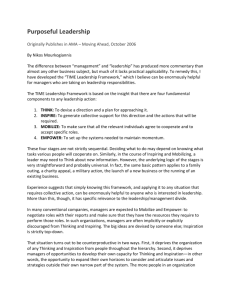SkillBrief Successful Leadership Great leaders are commonly
advertisement

SkillBrief Successful Leadership Great leaders are commonly described as "natural" or "born" leaders. Although some leaders seem to have been born to lead, this isn't always the case. Most inspiring leaders develop their leadership skills through hard work and effort over time. And they also rely on several key behaviors. To be an inspiring leader, you should demonstrate five behavioral traits: enable those around you to act share your vision challenge the existing system encourage others model the sort of behavior you're asking of others Enable Enabling others around you to act entails building a cohesive, collaborative team based around trust and honesty. There are three ways to enable others: cultivate collaboration – To effectively enable others to act, there must be a culture of collaboration. As leader, it's your job to cultivate this collaboration. This is important so there's a common sense of creation and responsibility. empower others – Enabling others to act means empowering them so that they take ownership of what they're doing. Giving people freedom to make decisions engages and empowers them. turn followers into leaders – Enabling others to act means ensuring that they're capable of acting on their own initiative – turning followers into leaders. This is about strengthening them, but also giving them more authority and responsibility. Share your vision Sharing your vision reflects progressiveness. To provide inspiring leadership, you need to imagine a positive future and be passionate about it – and convey that image and passion to others. There are three steps to sharing your vision: imagine the possibilities – To be an inspiring leader, you should look beyond what's happening today and imagine the possibilities of tomorrow. When imagining the possibilities, don't focus on your own personal vision – you should listen to what others and identify what's meaningful to them. enlist others – It's your job to awaken others' passions – making them proud and committed. You enlist others in the cause by appealing to common ideals and values. You do this by aligning the organization's vision with what matters to them. mobilize everyone –To mobilize everyone, a powerful approach is to animate the vision. This generates enthusiasm and excitement. It also motivates others to take decisive and courageous action. Challenge Inspiring leaders always look at how change could produce improvement, innovation, and growth, which reflects progressiveness. As part of this willingness to challenge the existing order, inspiring leaders do a number of things: anticipate change – An inspiring leader watches for coming changes and prepares the organization's response. Identifying these changes in advance – and addressing them when they happen – requires you to be flexible, creative, and competent. observe external developments – It's necessary to observe external developments, which means monitoring what's happening outside of your own organization to see changes before they occur. It's essential to talk and listen to others, whether they are employees, customers, suppliers, or anyone else with insight. seize the initiative – When challenged or when an opportunity presents itself, an inspiring leader seizes the initiative and makes things happen. It's often in times of difficulty or adversity that the qualities of an inspiring leader are most evident. experiment and take risks –You should work to create a climate within the organization where taking risks and experimenting are expected. Inspiring leaders know that it isn't success that breeds success, but rather it's failure that breeds success. Encourage As an inspiring leader, you provide more than guidance or direction – you provide energy and encouragement. People need this to consistently perform at a high level, behave courageously, or persevere. You encourage others in a number of ways: acknowledging contributions – When acknowledging contributions, you should explicitly recognize someone's effort or success. Doing this fosters a climate of appreciation and recognition. celebrating shared values – By celebrating shared values and achievements together as a group, you strengthen these values and improve performance. A celebration shows respect and appreciation, and fosters a sense of community. perpetuating success stories – Perpetuating success stories provides an example to others of what you want and expect from them. You should watch for instances of people doing things well – and tell others about it. Model You need to prove you're committed to the values you champion. To convince others of your personal commitment, it's important that you're seen to be doing exactly what you're asking others to do. You can do this in two ways: personify the common values and getting others to model these values – As an inspiring leader, it's your job to personify and represent your organization's common values to everyone – to people within your own group or organization and to those watching from outside. Try to serve these values as best you can. get others to model common values – An inspiring leader gets others to model the organization's common values. This means showing what's expected so others can also represent these values. Perpetuate success stories about how others have represented the values in their own behavior. There are five key traits that inspiring leaders demonstrate in their behavior. First, inspiring leaders enable others to act, which entails cultivating collaboration, empowering others, and turning followers into leaders. Second, they share their vision for the organization with those around them and, in doing so, imagine the possibilities, enlist others, and mobilize everyone. Third, inspiring leaders are willing to challenge the current way of doing things, and should – as part of this – anticipate change, observe external developments, seize the initiative, and experiment and take risks. Fourth, they encourage others, which includes acknowledging contributions, celebrating shared values, and perpetuating success stories. Finally, inspiring leaders model whatever it is they're asking of others by personifying the common values and getting others to model these values. Course: The Voice of Leadership: Inspirational Leadership Topic: Foundations for Successful Leadership © 2011 SkillSoft Ireland Limited









